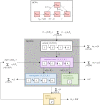The impact of testing and infection prevention and control strategies on within-hospital transmission dynamics of COVID-19 in English hospitals
- PMID: 34053255
- PMCID: PMC8165586
- DOI: 10.1098/rstb.2020.0268
The impact of testing and infection prevention and control strategies on within-hospital transmission dynamics of COVID-19 in English hospitals
Abstract
Nosocomial transmission of SARS-CoV-2 is a key concern, and evaluating the effect of testing and infection prevention and control strategies is essential for guiding policy in this area. Using a within-hospital SEIR transition model of SARS-CoV-2 in a typical English hospital, we estimate that between 9 March 2020 and 17 July 2020 approximately 20% of infections in inpatients, and 73% of infections in healthcare workers (HCWs) were due to nosocomial transmission. Model results suggest that placing suspected COVID-19 patients in single rooms or bays has the potential to reduce hospital-acquired infections in patients by up to 35%. Periodic testing of HCWs has a smaller effect on the number of hospital-acquired COVID-19 cases in patients, but reduces infection in HCWs by as much as 37% and results in only a small proportion of staff absences (approx. 0.3% per day). This is considerably less than the 20-25% of staff that have been reported to be absent from work owing to suspected COVID-19 and self-isolation. Model-based evaluations of interventions, informed by data collected so far, can help to inform policy as the pandemic progresses and help prevent transmission in the vulnerable hospital population. This article is part of the theme issue 'Modelling that shaped the early COVID-19 pandemic response in the UK'.
Keywords: SARS-CoV-2; coronavirus; mathematical model; nosocomial transmission.
Figures




References
-
- Sandri MT, Azzolini E, Torri V, Carloni S, Tedeschi M, Castoldi M, Mantovani A, Rescigno M. 2020. IgG serology in health care and administrative staff populations from 7 hospitals representative of different exposures to SARS-CoV-2 in Lombardy, Italy. medRxiv, 2020.05.24.20111245. (10.1101/2020.05.24.20111245) - DOI
-
- Houlihan C, et al. . 2020. SARS-CoV-2 virus and antibodies in front-line health care workers in an acute hospital in London: preliminary results from a longitudinal study. medRxiv, 2020.06.08.20120584. (10.1101/2020.06.08.20120584) - DOI
Publication types
MeSH terms
Grants and funding
LinkOut - more resources
Full Text Sources
Other Literature Sources
Medical
Miscellaneous
